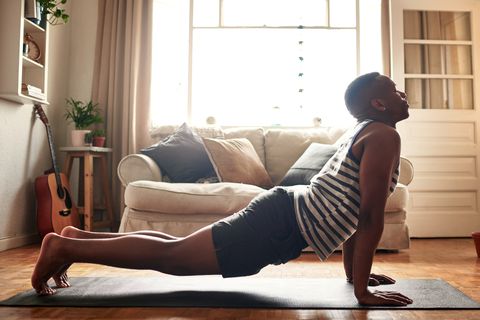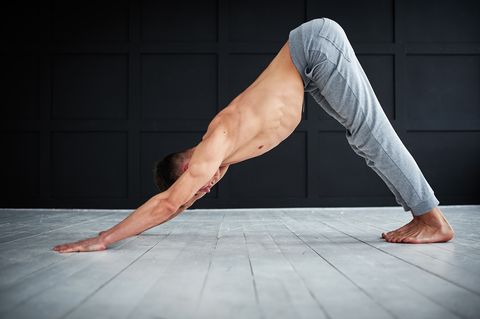Your Personal PT, Rachel Tavel, is a Doctor of Physical Therapy (DPT) and Certified Strength and Conditioning Specialist (CSCS) at Shift Wellness in NYC, so she knows how to get your body back on track when it’s out of line. In this weekly series, she gives you tips on how to feel better, get stronger, and train smarter.
If you think you’re too manly for a downward dog, think again. While some men might think yoga is strictly for the ladies, the very first yogis were actually exclusively men. In fact, you may be one of the only guys who hasn’t tried these positions yet—and in other news, you can wear leggings, too.
Yoga, which has been around for over 5,000 years, is one of the most popular forms of exercise for men and women alike. According to Dr. Lisa Blum, PT, DPT, CYT of Shift Wellness, yoga began as a male-only practice that included asana (postures), pranayama (breathing techniques), and meditation. It was seen as a way to improve both flexibility and strength while calming the mind. The “feminine” stereotype associated with yoga only began when it was westernized—so just like Pilates, many American dudes scoff only because they don’t understand.
Part of the reason yoga has become so popular in western society is for its physical and mental health benefits. Dr. Blum states, “There is a lot of new research coming out to support the benefits of yoga on overall wellbeing, happiness, and health” and she reminds us that the benefits are “not gender specific.”
Yoga is perfect especially in the current moment, for men working from home and missing the gym. You’d be surprised how much hitting the mat can invigorate your body and mind. While there are many varieties of yoga to choose from (Bikram, restorative, vinyasa, to name a few), the research is clear: they can all do good.
Major Health Benefits of Yoga for Men

PeopleImagesGetty Images
According to Dr. Blum, men can expect a few specific benefits from adding yoga to their workout routines.
Increased Mobility and Flexibility
Men typically focus their fitness on strength training and/or endurance training, such as running, weight lifting, or biking. While these workouts are great for muscle, bone, and heart health, the repetitive movements can lead to muscle, fascial, and nerve tightness. Yoga can be a great way to incorporate mobility work and flexibility into your fitness routine so that you are able to access your full range of motion at the gym.
Increased Body Awareness
Klutzy? Improving body awareness can go a long way in helping prevent injuries. Yoga classes emphasize the importance of correct form when practicing different poses. This attention to movement builds your proprioception, or knowing where your body is in space. By sharpening your proprioceptive skills, you improve your weight lifting form and balance, which decreases the likelihood of injury to your body.
Strengthens Deep Stabilizing Muscles
A big part of the typical gym routine includes using exercise machines and dumbbells to focus on building strength in the bigger, more visible muscle groups. Unfortunately, this often leaves out the deeper stabilizing muscles. This muscle imbalance can put your body at risk for injury. Yoga poses include a lot of core and trunk stabilizing movements that can strengthen the deeper muscles that are not addressed by many exercise machines.
Improves Heart Health
While you might think you have a good heart (we believe you), cardiovascular disease is the leading cause of death in men in the United States. The breathwork and meditation practices found in yoga have been shown to decrease heart rate, blood pressure, and cortisol levels in your body which all contribute to a healthy heart.
Yoga Moves to Start
So where should you begin? According to Dr. Blum, these 4 simple yoga exercises are a great way to get going. Knowing how to say the Sanskrit word for them, however, is optional.
Cat/Cow (chakravakasana)

KoldunovGetty Images
How to do it: Begin on hands and knees in a quadruped position, with knees under hips and shoulders in line with wrists. Inhale as you drop your stomach towards the ground and arch your lower back, looking upwards. Pause. Exhale as you round your back up towards the ceiling, allowing your neck to drop down. Repeat 5 to 10 times allowing breath to lead the movement.
Benefits: By mobilizing the spine and surrounding tissues, this move promotes blood flow which can aid in healing. Focusing on segmental movement of the spine (moving each vertebra individually as you go between cat and cow poses) can help free up or loosen stiff areas of the spine.
Downward-Facing Dog (adho mukha svanasana)

sandsunGetty Images
How to do it: Begin in quadruped. Walk your hands about a hand’s distance forward. Lift so you are supporting yourself by your hands and feet, knees off the ground. Push your hips back and upwards towards the ceiling, straightening the knees and allowing your heels to come off the mat if you feel tightness in your calves. Allow your spine to be long here and avoid rounding your back. If your hamstrings are tight and you have trouble keeping your back from rounding, slightly bend your knees to release some of the pull from the hamstrings. Hold for 3 to 5 breaths, then release.
Benefits: This pose allows you to actively stretch your hamstrings and calves, which are notoriously tight in men. It strengthens your shoulders in a weight bearing position, which has been shown to increase bone density. Lastly, it teaches you how to dissociate movements between your hips and your spine, which is extremely important in overall spine health.
Upward-Facing Dog (urdhva mukha svanasana)

KoldunovGetty Images
How to do it: Begin on your stomach. Place your hands on the ground in line with your chest. Draw your elbows close to your trunk. Point your toes away from you, allowing your weight to be on the tops of your feet. Lift your body up by straightening your elbows. Your weight should be on the tops of your feet and your hands. Your thighs should not be touching the floor. Draw your shoulder blades down and back, allowing your chest to stretch. Hold for 3 to 5 breaths, then slowly return back to your stomach.
Benefits: This pose actively strengthens the shoulders and upper back muscles while stretching the chest muscles. This combination of strengthening and stretching is needed to combat the slouched position most of us take on during our 8-hour work days. In addition to improving posture, this post is also great for stretching the abdominals and improving core strength and stability.
Boat (navasana)

fizkesGetty Images
How to do it: Start sitting upright on the floor with knees bent. Make sure your spine is lengthened here and not slouching, especially at your lower spine. Begin to lift your legs off the ground with legs straight, feet extended away from you and balance. If you have tight hamstrings, you will need to keep your knees slightly bent in order to prevent your lower back from rounding. As you stay in this pose, allow your spine to continuously lengthen, as the tendency is to round the back as you fatigue. Hold for 3 to 5 breaths and then slowly release.
Benefits: This pose is great for strengthening your core while actively stretching your hamstrings. In addition, it teaches you body awareness and how to dissociate the hips from the spine, which is important for spine health.
Want to expand your practice even further? Check out these other movements, and consider giving a yoga class a try.
Source: Read Full Article
